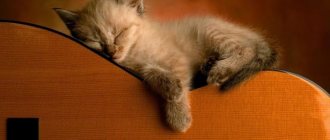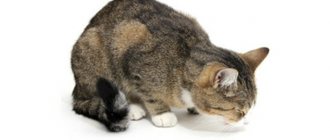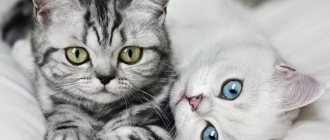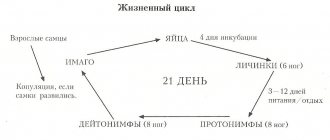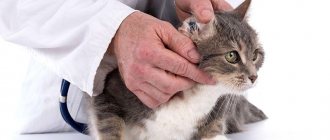Under what circumstances cats sweat cannot be determined, since they do not have such a heat exchange function. The only sweat glands that a pet has are located on its paws and are intended to mark territory, and not to reduce overall body temperature. The exception to the rule is Sphynx cats, which are hairless and may sweat. To reduce the temperature, the furry animal drinks water more often, licks itself, moves less and tries to stay in colder places. Sometimes the paws can leave wet marks due to the abundant secretion of the glands.
Where does a cat secrete sweat?
The cat's body has sweat glands, which are designed to improve heat exchange in the body of these animals. The main purpose of the sweating system is to prevent overheating. But in general, the functioning of this system in cats is far from perfect. There is practically no sweating in cats, since animals carefully monitor their condition, for example, choosing places to sleep where it is more comfortable to rest. When a cat is cold, its body is grouped, it curls up into a ball or sits with a ruff. But in the warmth, the animal’s body straightens, the cat stretches out.
Cats regulate the process of heat transfer by body position: they curl up into a ball in the cold or straighten out in the warmth.
A cat's thermometers are the nose and upper lip; these places are sensitive to even small changes in ambient temperature.
Sweat can be released through two types of glands:
- eccrine;
- Apocrine.
In humans, the main source of sweat is the eccrine glands, but in cats they are located only on the paws, more precisely, on the pads. Basically, only with their help does the cat sweat.
To see how a cat sweats, you need to look closely at the smooth floor on which the animal walks. There will be small wet marks left.
Unlike eccrine glands, apocrine glands cover the entire cat's body, but are most concentrated in four points:
- near the nipples;
- near the anus;
- on the cheeks;
- on the lips.
A cat can sweat not only from the heat, but also from strong nervous excitement. If we draw an analogy with a person, then his palms sweat at a moment of emotional stress.
How cats of different breeds sweat
The process of sweating depends not so much on the breed as on the thickness of the hair. It doesn’t matter whether the cat is long-haired or short-haired, they sweat the same, which cannot be said about their “bald” relatives - the Sphynx.
The lack of hair in sphinxes is caused by genetic features. Cats of this breed sweat all over their bodies . How strong the sweating will be depends solely on the pet: on its emotional state and health. Some representatives of the breed may sweat very little, but for others it becomes a whole problem. This cat needs to be constantly bathed or wiped with a damp cloth. And this can bring some discomfort to the owners, since the animal leaves wet brownish spots on the surfaces where it lies.
Sphynx sweat remains on the body in the form of brown spots
If the Sphynx's sweating is severe enough, then veterinarians advise having the animal diagnosed, as this may be associated with certain health problems.
Structure of a cat's paw
In its structure, a cat's paw has bones:
- ileum;
- ischial;
- pubic;
- femoral;
- tibia;
- tibia;
- heel;
- metacarpal;
- kneecap;
- hock joint;
- hip joint;
- metatarsus;
- fingers.
The lower limb has:
- tendons;
- proximal phalanx;
- middle phalanx;
- external phalanx;
- claw.
Skeleton of a cat's paw
The joints of cats are designed in such a way that when walking they turn in different directions. This helps the animal maintain balance. The flexibility of the joints helps, when falling, to turn around in such a way as to land on all limbs at once. The flexibility of the joints protects the murka from injury when jumping from great heights.
The front paws have 5 toes, one of which is located higher and does not reach the ground. The hind ones have four toes - the thumb is missing. There are pads on your pet's paw that help distribute weight evenly over the entire foot. Cats move on their fingers. This method of movement increases speed, lengthens strides and does not produce noise.
The hook-shaped claw is retracted into a pad, thus protected from environmental influences. When walking, the claws do not grind down, but if necessary, the cat puts them out and they serve as protection.
At the moment of an attack, the cat turns over on its back and puts forward its sharp claws, which can cause serious injuries to the enemy.
With their help, the predator hunts by biting into its prey. Under natural conditions, the animal constantly sharpens its claws on tree trunks. At home, to sharpen claws, it is recommended to install a scratching post, otherwise, if it is not available, the pet will sharpen its claws on the furniture.
How do cats cool down?
Due to weak sweating, cats are able to cool the body in other ways:
- Licking. In hot weather, cats actively wash and lick themselves. Body temperature decreases due to the evaporation of saliva from the surface of the fur.
- Let's drink. In the summer heat, cats can drink a lot. Water thins the blood, which helps the animal cool down and prevents health problems.
- Sleep. In hot weather, cats sleep a lot. Low mobility allows the cat's body to maintain body temperature at the same level.
- Condition of the coat. Wool plays a major role in the thermoregulation of an animal. By fluffing or smoothing the fur, a cat can cool the skin (the fur is close to the body) or conserve heat (the fur is fluffed, there is air between the hairs, which helps to retain heat inside).
- Searching for a suitable place. When the room is very hot, the animal instinctively looks for the coolest place in the house. This could be a tiled floor in the bathroom, a sink, or simply a ventilated area, that is, any surface that cannot heat up quickly.
Photo gallery: helping cats' thermoregulation mechanisms
Constant licking in hot weather helps a cat lower its body temperature.
Drinking frequently in hot weather prevents blood thickening and dehydration
When it's hot, cats look for cool places in the house.
It is worth noting that it is somewhat more difficult for kittens to carry out manipulations with self-cooling or heating. Their thermoregulation is imperfect, so they quickly freeze or overheat. Children should be closely monitored and helped to overcome discomfort. In nature, the mother cat monitors this, for example, licking them or moving them to a cool place. At home, this role falls on the owner.
About thermoregulation in dogs
Mammalian body temperature is controlled by the brain. Receiving impulses from the body, the central nervous system triggers defense mechanisms to support healthy functioning. Dogs are warm-blooded animals. This means that their body maintains an optimal body temperature regardless of external factors. In addition to the brain, thermoregulation in these animals is also carried out through electrolyte-salt balance. Dogs don't actually sweat. They have sweat-like glands on their bodies, located between their toes and on their snout. The secretion that is secreted from the glands on the paws has a liquid consistency. It evaporates quickly and thus cools the wetted surface. But those glands that are localized on the dog’s face secrete a thicker secretion with a special aroma. This is what contributes to the smell of wet dog. By the way, in the hot season, a dog can leave wet marks on surfaces. And this, in fact, is the only symptom that is characterized as sweating.
In situations where a person is sweating, the dog usually opens his mouth. He sticks out his tongue and breathes quickly. This is a cooling mechanism for dogs. Its essence is that the salivary glands begin to work more actively. Representatives of some breeds literally salivate. When water evaporates, it cools the surface on which it is located. And since saliva contains salts, and salt water evaporates faster, this helps dogs cool their airways, blood, and lungs. Surely many owners have noticed: when an animal breathes with its mouth open, its nose and ears become colder. This phenomenon is explained by the expansion of blood vessels and cooling of surfaces. Speeding up the heart causes blood to move through the vessels faster and cool down. Also, with the active production of saliva, the animal’s body loses electrolytes and salts. This, in turn, slows down the breakdown of carbohydrates. They are the main source of heat. When carbohydrates are not processed, the body cools faster.
What causes profuse sweating?
Excessive sweating is not typical for cats, so if this symptom appears, the owner should be wary. It can be a sign of both exposure to unfavorable factors and pathological conditions.
Diseases
When an owner notices that their pet is leaving wet marks more than usual, this may be a warning sign for them. Excessive sweating in your pet can be a symptom of various diseases. First of all, those associated with increased temperature:
- hemobartonellosis - an infectious bacterial disease that affects blood cells;
- feline AIDS, a viral disease that suppresses the immune system;
- viral leukemia - a disease associated with suppression of bone marrow functions;
- flu;
- infectious peritonitis, a fatal infection that attacks the immune system of cats;
- upper respiratory tract infections;
- panleukopenia - “distemper”, a viral disease that affects many systems of the cat’s body;
- toxoplasmosis is an infection caused by microscopic parasites.
Naturally, each of these pathologies is accompanied by a number of other symptoms. However, primary signs, which include profuse sweating, are prerequisites for urgent contact with a veterinarian.
Stress
In addition to illness, excessive sweating can cause stress. Most often, this condition is provoked by factors that irritate the nervous system, causing changes in the functioning of organs.
Stress can be short-term or it can last for a long time. Short-term stress most often passes painlessly. If an animal is stressed for a long time, then a malfunction of some system (for example, a thermoregulation system) or a disease occurs.
Causes of stress can be:
- physical damage, such as burns or injuries;
An injury to a cat is a stressful situation for it, especially if it is accompanied by long-term treatment.
- poisoning;
- hunger, vitamin deficiency;
- emotional disorders, for example, associated with moving, inattentive owner, etc.
Overheat
As the weather gets hotter, many cats may suffer from overheating. This condition may result in dysfunction of thermoregulation. A cat's body temperature can rise to 41 degrees. Signs of pathology are always clearly expressed. Prolonged overheating can be fatal. Those most susceptible to heat stroke are:
- kittens;
- pregnant cats;
- older animals.
These categories of animals are at risk because their bodies are weakened due to age or physiology. Also at risk are cats whose breed suggests a brachycephalic skull structure. In cats with a shortened muzzle, heat exchange processes are worse. This becomes a reason to pay closer attention to pets during the heat.
Cats with very long hair or thick undercoat are also at greater risk of heatstroke than others. Signs of overheating include:
- unnatural spread-eagled pose;
- breathing through the mouth with the tongue sticking out;
A cat breathing with its mouth open is a sign that the animal is overheating.
- shortness of breath;
- redness of the tongue and gums (bright red), but, on the contrary, atypical pallor is possible;
- wetness of paw pads;
- weakness and apathy;
- lack of appetite;
- severe drooling;
- vomiting with foam;
- convulsions;
- to whom (possible in severe cases).
I first observed overheating of an animal in my Thai cat. We lived in an apartment, but often went for walks together; she walked perfectly on a harness and even without it, not lagging behind me more than 4-5 steps. Not far from the house there was a forest and a meadow. And then one autumn (Indian summer) we went for a walk. The sun was shining and the weather was beautiful. About twenty minutes later, the cat began to leave the path and lie down in the thickets of grass on its side. I chalked it up to being tired; after all, we didn’t go for walks every day, and at home the animal had virtually no conditions for physical exercise. I gave her a few minutes of breathing space and then moved on. My “faithful dog” got up and followed me. And then I saw that the cat opened its mouth, stuck out its tongue and began to breathe heavily. I didn’t know how dangerous this condition was, but out of compassion for the animal, the walk ended there; the pet got home in my arms. Only later did I find out. that a cat's breathing is a sure sign of overheating, not fatigue.
Etiology
Pathophysiology
Cardiovascular changes: bradycardia, arterial hypotension, cardiac arrhythmias, decreased cardiac output and asystole. Initially, tachycardia and hypertension are observed. As hypothermia worsens, arterial vasodilation progresses, leading to hypotension and decreased cardiac output. (1) Respiratory effects: first, an increase in respiratory rate, then a decrease in the frequency and depth of breathing, trauma to the pulmonary alveoli, hypoxia of all body tissues. Slowing metabolism results in decreased CO2 production, thereby decreasing minute ventilation. Reduced motility of the ciliated epithelium creates favorable conditions for the development of pulmonary edema, bronchopneumonia and acute respiratory distress syndrome. (1)
Neurological effects:
from minor depression to coma. Hypovolemia, vasoconstriction of peripheral vessels, a leftward shift in the oxygen-hemoglobin saturation curve, and decreased liver function are all cold-induced abnormalities that are responsible for the development of lactic acidosis. (5) Due to reduced perfusion, acute renal failure, pancreatitis, and erosions of the gastrointestinal mucosa may develop. Both hypoglycemia and hyperglycemia, as well as hypo- and hyperkalemia, may occur. Hypocoagulation, disseminated intravascular coagulation syndrome, as well as leukopenia and thrombocytopenia may occur. (5)
Therapy
Antiarrhythmic drugs and catecholamines should not be used in cases of moderate to severe hypothermia because, even if the body responds to them, the response will be unpredictable. In addition, most pathological manifestations are eliminated only by increasing body temperature and correcting electrolyte and acid-base disorders. (2) Regardless of the method used, body temperature should rise at least 1–2 ºC per hour, and active rewarming should be stopped when body temperature reaches 37 ºC to prevent the development of rebound hyperthermia. (2) When measured rectally, the patient's body temperature may continue to fall for a period of time after rewarming begins. This phenomenon is caused by the return of cold peripheral blood to the central circulation and the movement of warm blood from the center to the periphery. In cases of severe peripheral vasoconstriction, passive superficial rewarming should always be accompanied by active internal rewarming to reduce the temperature difference between the central and peripheral circulation. During external rewarming, take precautions to prevent skin burns, e.g. adjust the temperature of the external heating devices themselves or place a thermal barrier between the heat source and the patient. (3) The evaluation and management of a patient with hypothermia should be the same as for any critically ill patient. Monitoring must be as thorough as possible. The method and technique of rewarming are based on the severity, duration and predisposing causes of hypothermia. (5)
- Passive external rewarming: The animal is covered with blankets to prevent heat loss and allow the body to produce heat itself. In general, this method is useful for patients with mild hypothermia who are otherwise healthy.
- Active external warming: the animal is wrapped and external heat sources are applied. This method is typically used to rewarm moderately hypothermic animals, malnourished animals with mild hypothermia, and animals that have not responded to passive rewarming.
- Active internal warming: peritoneal dialysis with a warm solution, warm lavage of the pleural space, lavage of the stomach or colon, warming of inspired air. Used in animals with a temperature less than 30°C, in animals with cardiac arrest due to hypothermia, or in animals that do not respond to other methods of rewarming.
People with a temperature less than 33.9 °C experience severe pain during rewarming, which is also observed in animals. After the temperature reaches 36.7 °C, it is recommended to administer narcotics to relieve pain. (5)
Tips for cat owners for hot weather
Owners need to closely monitor their cat's condition during the summer heat. You should pay attention to some recommendations that will make it easier for your cat to tolerate the heat:
- If a long-haired cat or a pet with undercoat does not tolerate heat well, they can be cut short in the summer.
- Cats need to be brushed periodically with special brushes. In addition to improving the condition of the coat, this will increase the ability to thermoregulate.
- You cannot force your cat to move actively. It is best to give the animal rest.
- Your cat should always have unlimited access to fresh drinking water.
- You cannot drive an animal from a resting place, for example, from the tiles in the bathroom. The cat instinctively lies down in the most comfortable place for itself.
The Sphynx cat requires special attention. In hot weather, such a pet can sweat profusely. It must be bathed or wiped with a damp cloth in a timely manner. Excess sweat gland secretions and blocked ducts can cause acne.
Video: how to help cats in hot weather
How to prevent overheating and help your cat with heatstroke
In hot weather, owners need to pay special attention to their cat, because it is better to prevent overheating than to eliminate the consequences of heat stroke. These recommendations will help owners protect their cat’s health even in the hottest weather:
These recommendations will help owners protect their cat’s health even in the hottest weather:
- A long-haired pet can be cut short for the summer.
- Do not force your cat to move actively in the heat.
- Provide your pet with constant access to cool, fresh drinking water, and if you are traveling anywhere, always take a collapsible drinking bowl with you.
- Do not kick the cat out of a cool place, because he instinctively settles down where it is cooler.
- Do not leave your pet in a locked car.
- Periodically bathe your cat with cool water.
- Brush your pet more often than usual to provide air access to the skin.
- Cover the cat with a towel soaked in cold water.
If none of the preventative measures help, and the cat suffers from heatstroke, you must do the following within 20 minutes:
- Move your pet to the coolest room, turn on the fan or air conditioner.
- Give it something to drink, and if the cat refuses water, forcefully introduce it.
- You are allowed to gently dip your pet into a basin of cool water. However, in this case, you need to be sure that the cat is not prone to stroke or heart attack. Otherwise, everything could end in death.
- Wrap your pet in a damp cool towel or wipe the paws and face with a wet napkin.
- Give your cat a limb massage to improve blood flow.
After the body temperature has decreased to at least 39.5°C, it is better to leave the cat to rest in a cool place, but continue to monitor him for 1–2 days. If symptoms of overheating reappear, the algorithm of actions must be repeated again.
Every owner should know the symptoms that indicate that the cat needs to be taken to the veterinarian immediately:
- Blue mucous membranes when breathing with an open mouth.
- Problems with orientation in space.
- Inability to focus your eyes.
- Vomit.
- Salivation.
- Copious nasal discharge.
- Bad breath that has never been observed before.
- Weak pulse.
- Pupils that are too dilated or constricted.
- Slow or irregular breathing.
- The absence of any reaction to a sudden approach of the palm to the muzzle - in a normal state the pet should blink.
Heat stroke is extremely dangerous for the health of representatives of the cat family. If dangerous symptoms appear, you should not try to help the cat yourself. Examination and prescription of treatment methods should be carried out only by a veterinarian.
The thermoregulation mechanism of domestic cats can hardly be called perfect. Unfortunately, their perception of heat and cold is dulled, so they are susceptible to heatstroke.
Attentive attitude towards the pet on the part of the owner and compliance with recommendations for the prevention of overheating will allow the cat to easily endure even the most intense heat.
I like1I don't like
Techniques for preventing overheating
The well-coordinated and efficient heat exchange system described above is no less successful than “sweating” in humans. However, this does not mean that at high temperatures the dog can be walked or kept in the sun without fear.
Under the influence of dry, overheated air and heating by direct sunlight of fur, especially dark-colored fur, the animal not only increases its breathing rate, but also deepens it, which leads to hyperventilation of the lungs. In this case, the blood loses a significant amount of carbon dioxide, its pH shifts to the acidic side, and manifestations of respiratory alkalosis are noted:
- deterioration of microcirculation in tissues;
- the occurrence of ventricular and atrial tachycardia;
- the appearance of muscle cramps, tetany;
- mental disorders - anxiety, agitation, aggression;
- electrolyte imbalance.
To prevent your dog from suffering from hyperthermia, the following rules must be followed during the hot period:
- walk in the morning or evening hours;
- avoid intense physical activity;
- have a supply of water with you so that you can give your dog a drink or wet its fur at any time;
- After a walk, rinse the paw pads, face and fur on the back with cool water, and give the dog a drink of cool, fresh water.
In a normal state, a dog is able to withstand high temperatures for a long time, but dehydration leads to a rapid increase in body temperature, a decrease in breathing rate, and impaired blood flow, which causes a “failure” of all thermoregulation systems and can lead to the death of the animal.
Evolution has very rationally “provided” living organisms with thermoregulation mechanisms, and dogs have one of the most interesting and effective ones, taking into account the structural features and physiology of these animals.
Dogs have some physiological characteristics that can rightfully be considered amazing. For example, dogs have 42 teeth, they sense human diseases by smell and chew inedible objects depending on the lack of a particular substance in the body.
The question of how dogs sweat causes a lot of controversy and speculation.
